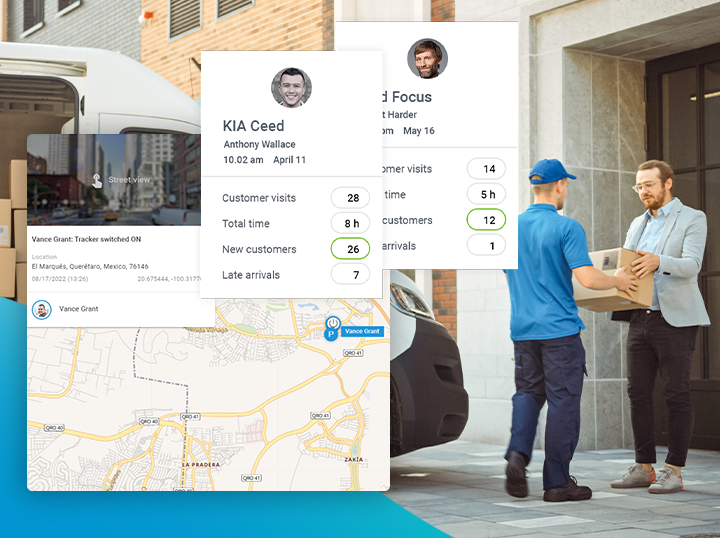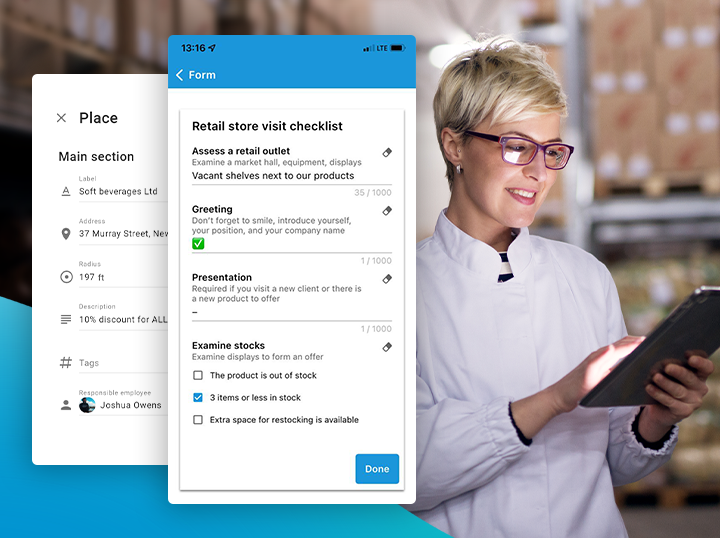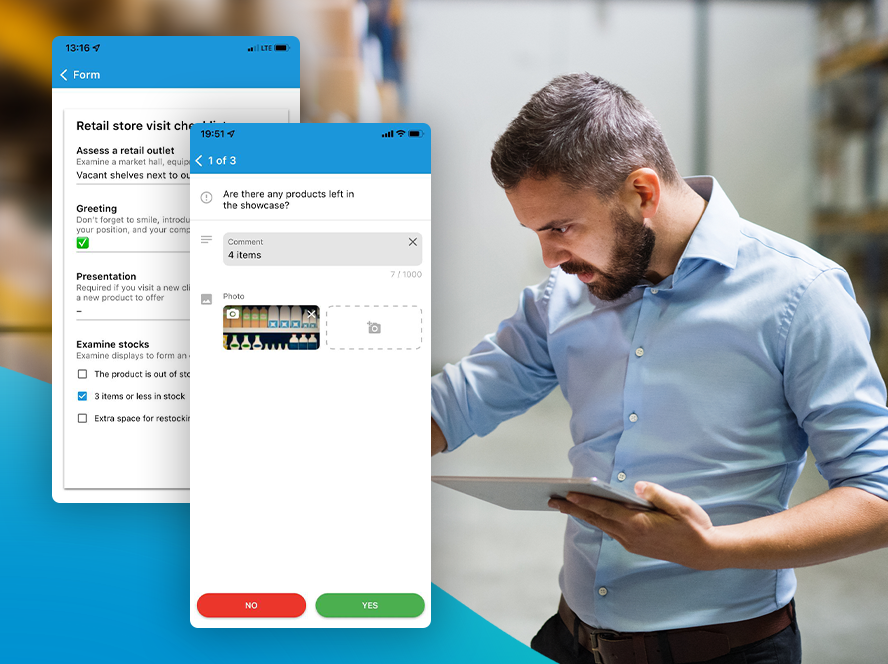The last mile problem exists for many industries because the last mile delivery consists of so many moving parts. Read on to learn how grocers, florists, bottled beverage, and furniture companies can improve the last mile.
- What is the last mile problem?
- The last mile problem for grocers
- Solving the last mile problem for grocers
- The last mile problem for florists
- Solving the last mile problem for florists
- The last mile problem for bottled beverage companies
- Solving the last mile problem for bottled beverage businesses
- The last mile problem for furniture delivery businesses
- Solving the last mile problem for furniture delivery businesses
In an ideal world, producing a product would be the end of the line for businesses. Simply get it made, box it up, and celebrate the work done. Unfortunately, that’s not the reality, especially for some of the industries we’re going to discuss today, namely grocers, florists, bottled beverage businesses, and furniture companies.
In fact, especially for these industries, having a viable product is probably less than half the battle. Delivery is of the utmost importance because their products either have a limited shelf-life or are breakable, which means that success in the last mile delivery phase must be considered with extreme care and caution to meet customer expectations so as not to become deluged by returns of throw-away products.
Time and extreme care is of the essence for these businesses, and to top it off, the last mile is the most expensive part of the process, hence the last mile problem. Fortunately, problems oftentimes have solutions.
In this article, we’ll dive into what the last mile problem is for grocers, florists, bottle beverage companies, and furniture businesses and discuss methods each business can use to solve it.
But first, let’s define the last mile problem in general terms.
What is the last mile problem?
The main contributing factor to the overall last mile problem is the fact that it consists of so many moving parts that must be executed accurately and efficiently at scale.
From start to finish:
- An order is received
- The delivery route is planned
- The delivery is scheduled
- The goods are appropriately sorted before loading onto delivery vehicles
- The goods are loaded on the delivery vehicle according to the route
- The delivery driver executes deliveries according to the routes
- Pending variables, the delivery is made
When reading it, it seems like a reasonable process that simply goes from one thing to the next, but the devil is in the details. Since there are so many moving parts, the last mile problem quickly becomes cost. According to Business Insider, last mile delivery accounts for 53% of the total cost of shipping.
Solving the last mile problem is the combined effort of trying to deliver goods efficiently in both measures of cost and time, safely, and transparently so customers have insight into the process.
Now, let’s learn how the last mile problem affects the industries we mentioned above.
The last mile problem for grocers
Online grocery delivery has become more and more popular over recent years, and especially so during the COVID-19 pandemic. As of 2019, 52% of grocery stores offered home delivery or in-store pickup.
When shopping at the grocery store in person now, it’s easy to see that many shoppers are actually shopping for someone else.
With the home grocery delivery trend only set to increase year over year, grocery stores must work to solve the last mile problem for their industry, namely: cost, timeliness of delivery, food safety, and order visibility.
Cost
Most large grocers that offer grocery delivery services do not charge for delivery (often as long as the customer reaches a purchase minimum), which customers have come to expect as part of the service. This means that small grocers must take on the cost of delivery if they want to be competitive in the space so it’s imperative that they run a tight ship.
Timeliness of delivery
Customer expectations for their deliveries run high, no matter what they’re receiving, and expectations might even be higher for vulnerable items, like groceries. So it’s imperative to not only get their orders right, but make sure they arrive on time as well.
Food safety
Just as much as customers don’t want their ice cream to melt, they don’t want their frozen vegetables to thaw out and become mush, or their milk to go sour sitting at room temperature for hours. That’s why it’s important not only for grocery deliveries to make it on time, but for certain vulnerable items to travel in a temperature controlled environment.
Order visibility
Customers need to be able to choose their delivery windows so they can be home to accept the delivery and transfer any vulnerable items to the fridge or freezer.
Solving the last mile problem for grocers
- Use the right delivery vehicles — Having the right delivery vehicles is key so make sure they can withstand a temperature controlled environment to ensure vulnerable food items stay fresh.
- Keep your customers in the loop — Delivery management solutions can help keep your customers in the loop on their order progress. Better yet, your delivery drivers only have to update their progress in the app, which can trigger a message to customers letting them know the progress of their delivery from store to door. With real-time GPS tracking tools, customers can view their delivery on the map as it approaches in real-time, keeping drivers accountable and accurate to maintain customer satisfaction. Proof of delivery through photos helps confirm delivery and prove accuracy.
- Use the correct grocery delivery accessories — Double down on ensuring grocery deliveries make it to their destination fresh by using insulated delivery bags or even temperature controlled delivery lockers that can widen the delivery window.
The last mile problem for florists
The growth of ecommerce has kept florists part of a delivery industry that they know well. Florists face a number of last mile delivery problems shared by grocers, but they also have a set of unique last mile problems that are particular to their industry.
The main last mile problem for florists: delivering stunning plants and flower arrangement to customers quickly and damage-free.
The holiday surge
Florists often see a massive surge in business during Valentine’s Day and Mother’s Day, so they must be adept at being able to increase delivery capacity during these peak seasonal shifts.
Temperature control
Much like many grocery items that become volatile if they sit under the wrong temperatures for too long, the same goes for plants and flowers. To avoid sad, wilted deliveries that are sure to disappoint and frustrate customers, florists must keep their deliveries in temperature controlled environments that keep their products alive and healthy.
Cargo management
Safe delivery means ensuring that the cargo arrives undamaged, and plenty more can go wrong for florists than the temperature of a delivery vehicle. To solve the last mile problem for florists, florists must ensure that their products — which can differ greatly from size and shape, and often include glass vases — do not shift during transport to avoid breakages and spoilage.
Solving the last mile problem for florists
- Choose the correct vehicles — Florists must not overlook this step. It might be best to be picky in this area to ensure that your business gets the most out of its delivery vehicles for the long term.
- Plan for efficiency — With order fluctuations prevalent in an industry that has intense holiday surges, it’s important for florists to adopt affordable software delivery solutions that can help them manage the moving parts of last mile delivery better, faster, and more efficiently than ever before. Last mile delivery software solutions like B2Field, can offer SMB delivery businesses automatic routing and dispatching to ensure deliveries are executed efficiently no matter what the seasonal demand looks like, so you can scale your fleet up and down as needed in an affordable way.
The last mile problem for bottled beverage companies
Similar to grocers and florists, bottled beverage companies need to get their products delivered fast and intact, and as such, they share many of the same last mile delivery problems as the other businesses.
Cargo management
Bottled beverages come in all shapes, sizes, and pressurizations, which means transporting them carefully is of the utmost importance. Take into consideration in what environment you’re shipping your products. Is it a smoothly paved urban area where cargo rides relatively safely, or is it rough mountain terrain where beverages need extra protection?
Temperature control
Similar to groceries and flowers, some beverages need to maintain a consistent temperature to remain potable so bottled beverage companies must have temperature controlled delivery vehicles.
Delivering on time
Again, different beverages have different delivery requirements. Some have a long shelf-life at room temperature, while others have to be delivered within a certain time frame after production. It’s important for bottled beverage companies to adopt affordable delivery software solutions to help manage deliveries to maintain and improve efficiency standards.
Solving the last mile problem for bottled beverage businesses
- Choose the correct vehicles — With many delivery vehicles offering climate-control technologies, it’s imperative for bottled beverage companies to choose the right vehicle depending on such factors. After all, it could be a huge waste of money to invest with vehicles with such technology if the beverages they provide are shelf-stable at room temperature.
- Cargo management and employee training — Cargo management solutions are particularly important for bottled beverage companies, as well as the importance of employee training for such solutions, including the proper use of loading and unloading vehicles and how to properly use tie-downs.
The last mile problem for furniture delivery businesses
Furniture companies have to manage the movement and storage of many different materials, ranging from large dense, heavy wooden products and metal products, to small, fragile items such as mirrors and glass. Therefore, safety and assistance are some of the most important factors for furniture companies.
The size and weight factor
Considering the world of difference between an antique cherry wood Armoire and a full length mirror, furniture companies can help solve the last mile problem by ensuring their delivery teams have all the personnel, tools, and safety equipment (including training) they need to do the job right. It might take one delivery person to deliver a full-length mirror, but it will take a team of 2 or 3 with the right tools to deliver an antique cherry wood Armoire.
Offer dynamic delivery windows
Customers who order furniture often need to be home to accept their deliveries so offering them the ability to control the delivery process is key. One way to do this is by offering delivery windows that can be updated by them to reflect the changing nature of their busy lives to ensure delivery success.
Concierge services
Some furniture delivery companies offer concierge services such as white-glove delivery and in-home assembly or set-up. It’s important to factor in the amount of extra time it takes for delivery personnel to cater to customers who need such services, while maintaining set delivery schedules for the rest of the shift.
Solving the last mile problem for furniture delivery businesses
- Thoroughly train delivery personnel — Your delivery personnel should have hands-on experience assembling the most popular items your company offers so they know what it takes to deliver and assemble furniture in a timely manner that allows them to maintain the day’s delivery schedule.
- Ensure drivers have the right tools — Especially when dealing with dangerous and/or fragile heavier items, you must ensure that your delivery teams take safety precautions so they remain healthy. Providing them with all the right tools they need to protect themselves and others is as important as giving them the tools they need to execute in-home assembly.
- Schedule accurately — Last mile delivery software solutions can offer furniture companies the accuracy and reliability needed to plan routes as efficiently as possible, while factoring in service times to ensure delivery teams stay on schedule throughout the day.
Want to learn more about how B2Field last mile delivery software helps SMB delivery businesses thrive? Check out our website.






















